It was a series of collisions of massive, frigid arctic air masses with the warming airs
from the Japanese current off the Gulf of Alaska which set the stage for the heavy
snowfall. The systems stalled in place over the lower Wrangells, guaranteeing
disaster. The build-up of layer after heavy layer of wet snow was followed by a
final area-wide blizzard which destroyed the trams and power lines to the mines,
isolated Kennecott and closed the railway. As April gave way to May, the arctic
air retreated to the far north, allowing a wave of clear, warming weather to
replace it Fresh snows built up so heavily in those last few days of the
extended winter storm rapidly melted away. Breakup quickly took hold throughout
southcentral Alaska as warm airs dominated the region.
snowfall. The systems stalled in place over the lower Wrangells, guaranteeing
disaster. The build-up of layer after heavy layer of wet snow was followed by a
final area-wide blizzard which destroyed the trams and power lines to the mines,
isolated Kennecott and closed the railway. As April gave way to May, the arctic
air retreated to the far north, allowing a wave of clear, warming weather to
replace it Fresh snows built up so heavily in those last few days of the
extended winter storm rapidly melted away. Breakup quickly took hold throughout
southcentral Alaska as warm airs dominated the region.
Bert Nieding rode the first train in after waiting for the resumption of railroad service
from Cordova to the mines. His was a special passenger train consist headed by
Mikado No. 71. Among the ticketed riders was the deputy marshal and coroner.
A second train followed with a load of box cars heavy in supplies. It also
pulled forty empty steel flat cars and the caboose. In front of both mainline
trains was rotary no. X-4, being pushed by engines no. 21 and no. 22 in
tandem. Behind the two engines was a work train consist which included a bunk
car, a diner, two box cars and the oddball work train caboose that had no
cupola.
from Cordova to the mines. His was a special passenger train consist headed by
Mikado No. 71. Among the ticketed riders was the deputy marshal and coroner.
A second train followed with a load of box cars heavy in supplies. It also
pulled forty empty steel flat cars and the caboose. In front of both mainline
trains was rotary no. X-4, being pushed by engines no. 21 and no. 22 in
tandem. Behind the two engines was a work train consist which included a bunk
car, a diner, two box cars and the oddball work train caboose that had no
cupola.
Before this group of three trains was allowed to proceed, another rotary consist had
cleared the line all the way to Tiekel. The second consist followed once notification
arrived that rotary train no. 20 had arrived at CRNW mile 101. The second
rotary would clear the next section all the way to Kennecott, if necessary.
Sometimes Kennecott would go through several years of winters without ever
seeing a rotary train. This year was unusual.
arrived that rotary train no. 20 had arrived at CRNW mile 101. The second
rotary would clear the next section all the way to Kennecott, if necessary.
Sometimes Kennecott would go through several years of winters without ever
seeing a rotary train. This year was unusual.
George Brown notified Cordova that the trestle crossing across the Copper River had
been completely unaffected by the late winter storm. The ice on the river had
already gone out and the recently rebuilt bridge stood solidly in place.
already gone out and the recently rebuilt bridge stood solidly in place.
Because the area was still drifting, the passengers were on edge. Each one feared
additional delays. Bert Nieding, like the other passengers, watched closely as
the coach passed each whistle-stop sign from Goat Mountain to Childs Glacier, to
Abercrombie, Moraine, Baird, Bremner, Cascade, Cleave and Tiekel. The rotary
that had been sent ahead three days before had begun running its whirling blade
from the Copper River delta at CRNW, mile 27, Flag Point. It never stopped,
except to be placed back on the track after a number of de-railings, until it
reached Tiekel at mile 101.
Abercrombie, Moraine, Baird, Bremner, Cascade, Cleave and Tiekel. The rotary
that had been sent ahead three days before had begun running its whirling blade
from the Copper River delta at CRNW, mile 27, Flag Point. It never stopped,
except to be placed back on the track after a number of de-railings, until it
reached Tiekel at mile 101.
The proximity of rotary train no. 21 meant that Mainline No. 71 was moving at a very slow pace. The rotaries were required to travel at no more than ten miles per hour.
Paddy McMahon, the deputy marshal from Valdez was sitting near Mr. Nieding. He had
already met the Kennecott executive at the Cordova station. McMahon wanted to get
in the good graces of the corporation. Kennecott was the only company that mattered in
this part of the country, since it owned not only the single major mine in
southcentral Alaska, but the CRNW Railway and Alaska Steamship plus the
Northwest Literage Company. It was well known that the company held a strong
influence over the legal system at Cordova and even Valdez.
this part of the country, since it owned not only the single major mine in
southcentral Alaska, but the CRNW Railway and Alaska Steamship plus the
Northwest Literage Company. It was well known that the company held a strong
influence over the legal system at Cordova and even Valdez.
As the coach passed Cascade, Paddy sat down next to Bert Neiding to strike up a conversation.
“I knew the men who worked there at Cascade well. I came up with that group during
the old railroad construction days. There were many of us Irishmen who worked the
railroad. I went on to work for the territorial government, but several of my
compatriots stayed on with this railroad. The Cascade bunch all died the same
day in a trestle accident at Chitina. I was the acting coroner even back then.
Now I’m up for the job of Marshall. No more of this coroner work. Too
distasteful.”
railroad. I went on to work for the territorial government, but several of my
compatriots stayed on with this railroad. The Cascade bunch all died the same
day in a trestle accident at Chitina. I was the acting coroner even back then.
Now I’m up for the job of Marshall. No more of this coroner work. Too
distasteful.”
“It was just another bad accident, wasn’t it, Paddy?”
“That was my conclusion. We never found any of the bodies from the trestle collapse.
We rarely do when somebody is swept into the Copper River. The rumor was that it
all happened because of some kind of old Indian curse. Some have said that our
Irish boys disturbed some old Indian graves near Chitina years ago and the
spirits from the deep came up and pulled them into the river. I’m too practical
a man to believe in superstition, but I suspect the Indians had something to do
with the accident. Just couldn’t prove it. They’ve been known to sabotage the
railroad before, you know. Can’t trust those siwash bastards.”
all happened because of some kind of old Indian curse. Some have said that our
Irish boys disturbed some old Indian graves near Chitina years ago and the
spirits from the deep came up and pulled them into the river. I’m too practical
a man to believe in superstition, but I suspect the Indians had something to do
with the accident. Just couldn’t prove it. They’ve been known to sabotage the
railroad before, you know. Can’t trust those siwash bastards.”
Bert looked at the large, balding man in disbelief. He was astounded that someone
with such a primitive attitude could have been promoted to deputy marshal. Worse yet,
he said he was in line for the job of marshal itself. Bert had little knowledge of
Native ways. He never thought much about Natives. But he was certain that no
such sabotage could have occurred. It did not fit with anything he had ever
known.
Native ways. He never thought much about Natives. But he was certain that no
such sabotage could have occurred. It did not fit with anything he had ever
known.
“Really? Did you find compelling evidence which led you to that incredible conclusion?”
“Evidence? No. Just a hunch. No witnesses on that trestle collapse. No one would talk.
Not even the white men who worked on the Chitina crew had anything to say. But
those siwash hate us, you know. Every chance I get I try to make it right.
It’s still a war going on out here, but we won this territory fair and square.
It’s ours. The Indians will just have to take what they get and be happy with it.”
those siwash hate us, you know. Every chance I get I try to make it right.
It’s still a war going on out here, but we won this territory fair and square.
It’s ours. The Indians will just have to take what they get and be happy with it.”
“Pardon me, Mr. McMahon, but I don’t care much for your primitive and provocative attitude.
If you don’t mind, I’d kindly appreciate it if you’d sit elsewhere.”
He thought he was buttering up to me. He probably thinks Kennecott can assure him the job. Guess I’ll have to prove it to him. We’ll see he never gets to be marshal. Need to find a new deputy, too. Retire that Irish bastard before he inflames the Indians. That attitude of his could get us all in trouble. Glad he found me before it’s too late.He won’t be so happy, though.
Nieding got up and went back to the dining coach to have some coffee. He found the words of
the coroner very disturbing.
the coroner very disturbing.
I hope our railroad company isn’t part of what I just heard. We’ve made enough money out here without beating it over the head of the Natives who’ve never gotten in our way. Disgusting man that Irish cop. He’s through.
Bert looked up from his thoughts. The man delivering his coffee was Tom Bell, a
pleasant-looking Ahtna Indian from Chitina. The Native railroad employee smiled
as he delivered the coffee, unaware of the disturbing words Mr. Nieding had just
heard.
pleasant-looking Ahtna Indian from Chitina. The Native railroad employee smiled
as he delivered the coffee, unaware of the disturbing words Mr. Nieding had just
heard.
“Is there anything else I can do for you, Mr. Nieding? We’re honored to have you up
here. Just let me know what you need. I’ll be around.”
here. Just let me know what you need. I’ll be around.”
Bert thanked him and then felt very guilty that he could in any way be part of a system which
included the likes of McMahon.
included the likes of McMahon.
God help us all. They don’t deserve the likes of McMahon.
It was slow going into Chitina. The drifted snow had compacted along the narrow ledge of the
railroad right-of-way a hundred feet above the river. But the comfortably train
with its exceptional food service under Tom Bell finally chugged into the
depot. Nieding was the first one off. He immediately entered the station and
telegraph office.
railroad right-of-way a hundred feet above the river. But the comfortably train
with its exceptional food service under Tom Bell finally chugged into the
depot. Nieding was the first one off. He immediately entered the station and
telegraph office.
“Hello, George. I need to check in with my office and also with Kennecott.”
“Mr. Nieding,” George said, standing up from behind his glassed-in counter, “I
haven’t seen you in these parts in quite some time. There’s rumors of some
sort of disaster up at Kennecott. What’s going on? Is that why you’re back?”
haven’t seen you in these parts in quite some time. There’s rumors of some
sort of disaster up at Kennecott. What’s going on? Is that why you’re back?”
“No disaster. Lost a few miners in a cave-in. That’s all. I have a coded message for
superintendent Douglass. It’s written out for you,” Bert said, handing George
the indecipherable piece of paper.
superintendent Douglass. It’s written out for you,” Bert said, handing George
the indecipherable piece of paper.
Well, Mr. Nieding, you really are hiding something.
It must be bad up there, whatever it is.
“I’ll send it right away, Mr. Nieding.”
“How’s the condition of the tracks the rest of the way, George?”
“You’ll need the rotary ahead of you all the way up. Some sections are still drifted over.
We’re sending it off right away. It’ll be faster going than that first hundred-plus miles, however.”
We’re sending it off right away. It’ll be faster going than that first hundred-plus miles, however.”
 |
| Snow slide near Kennecott in 1917. --Ben Jackson photos |
 |
“This is an urgent matter. Have that rotary out there as soon as possible. Send as many
extra crewmen from out of here as you have available. I’ve got to get there as
soon as possible.
extra crewmen from out of here as you have available. I’ve got to get there as
soon as possible.
Mainline No. 71 became Local No. 71 as it left Chitina for Kennecott. It announced its leaving with the usual loud blast of the whistle. Resembling very much the July 4th
Special, No 71 included two combines, a day coach and the observation and dining
car. Only the observation car and one of the combines was in use.
Special, No 71 included two combines, a day coach and the observation and dining
car. Only the observation car and one of the combines was in use.
Something strange going on, all right.
Never seen so many cars in one train consist in the spring.
Never seen so many cars in one train consist in the spring.
George walked out on the platform to join a sizable crowd of Chitina residents watching the strange consist pull out of the depot. The air was heavy with rumors and speculation.
Chitina Local No. 71 did not catch up with rotary consist no. 21 until it it reached the
flatlands beyond the Gilahina trestle. It was dark by then when the engineer
spotted the red running lights of the caboose at the tail of the rotary consist
far ahead along a straight stretch of track leading toward the Lakina River
trestle. It would be a slow run all the way into McCarthy.
flatlands beyond the Gilahina trestle. It was dark by then when the engineer
spotted the red running lights of the caboose at the tail of the rotary consist
far ahead along a straight stretch of track leading toward the Lakina River
trestle. It would be a slow run all the way into McCarthy.
Nieding stayed in the diner away from the coroner Paddy McMahon, who was in one of the coach cars. Tom Bell brought in his meal of roast duck with some fine cabernet wine.
Bert studied Tom for a moment.
Bert studied Tom for a moment.
I wonder what he’s really thinking. How do the Natives really
see us? Never gave it much thought. Maybe I should have. Maybe all of us should have thought more about what we’re really doing
here. Too late now. This man is quite a cook and a very courteous waiter as well . I see he carefully avoids any small talk with me or anyone else. Can’t imagine these humble people actually sabotaging us like McMahon insists. It just doesn’t fit.
see us? Never gave it much thought. Maybe I should have. Maybe all of us should have thought more about what we’re really doing
here. Too late now. This man is quite a cook and a very courteous waiter as well . I see he carefully avoids any small talk with me or anyone else. Can’t imagine these humble people actually sabotaging us like McMahon insists. It just doesn’t fit.
The train pulled up to McCarthy to wait while the rotary continued on with its final
clearing the last few miles into Kennecott. It was after midnight and
pitch-black.
clearing the last few miles into Kennecott. It was after midnight and
pitch-black.
Good. No point in these town people noticing this large, empty passenger train. We’ll be sending back a lot of laid-off Mother Lode workers on it. No need to get the speculation going ahead of time. Hope we didn’t cause too much of a stir in Chitina.
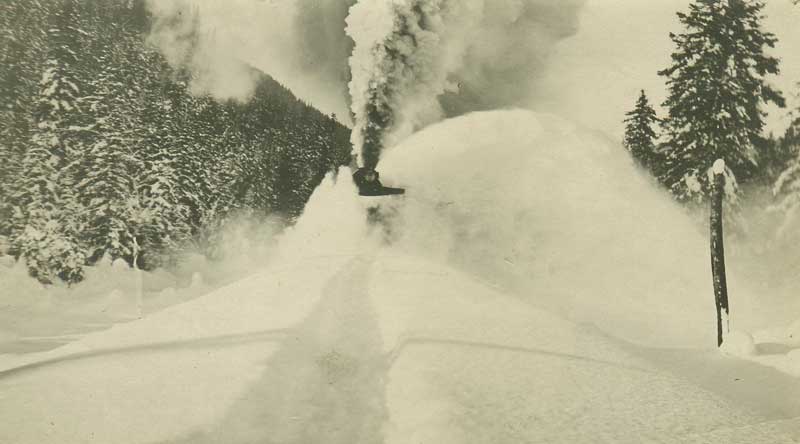 |
| Clearing the railroad line between McCarthy and Kennecott --Richelsen Continue |

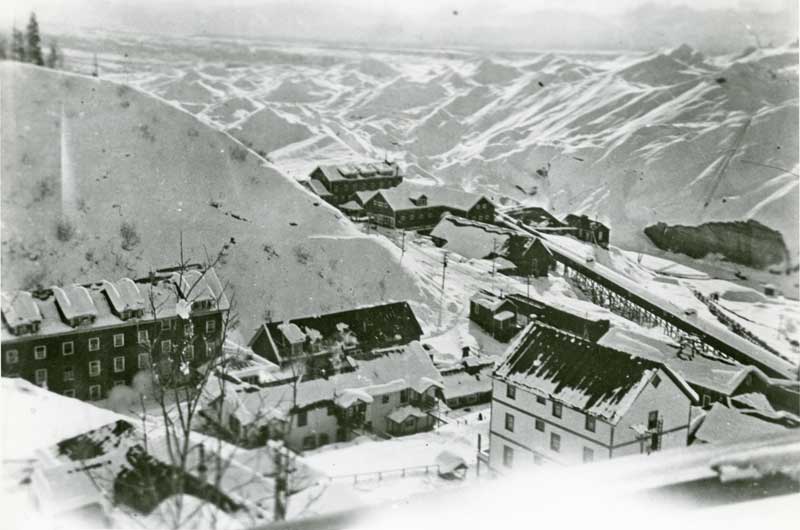
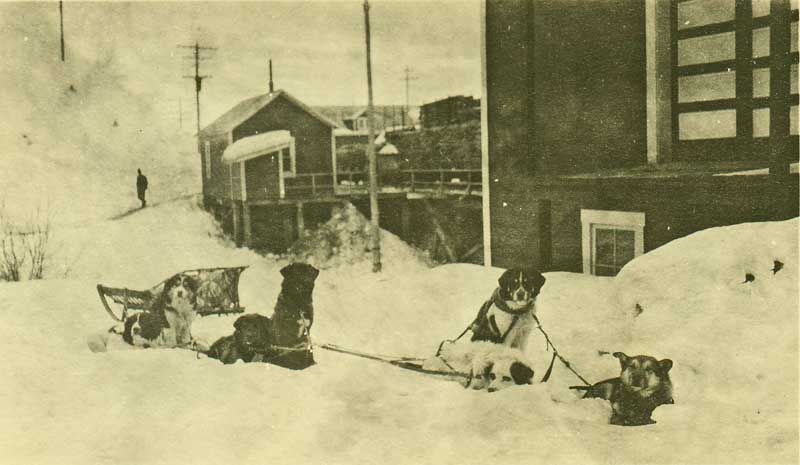
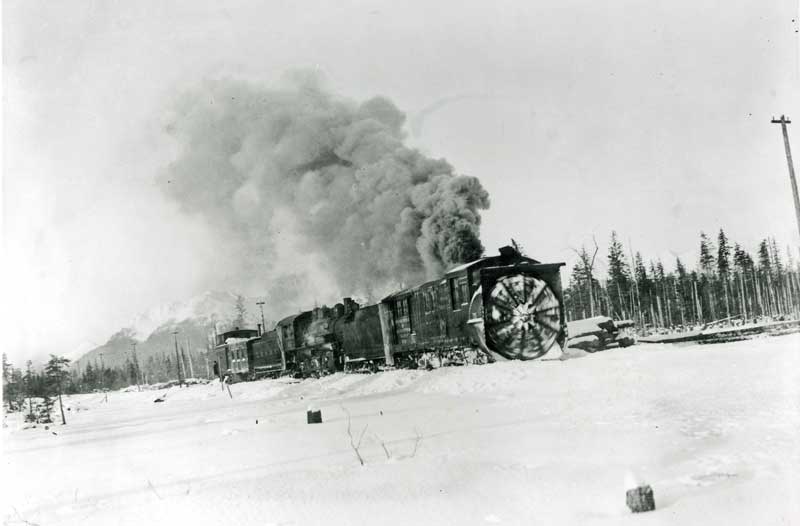
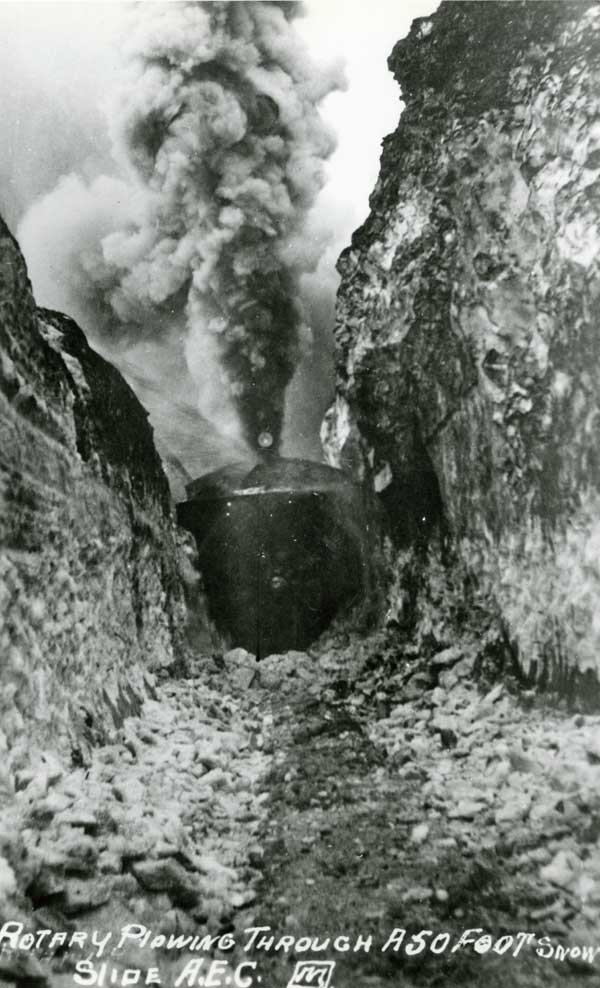
1 comment:
Between the Mother Lode tragedy and the heavy 1917 snowfall the KCC community had much to deal with!
Post a Comment